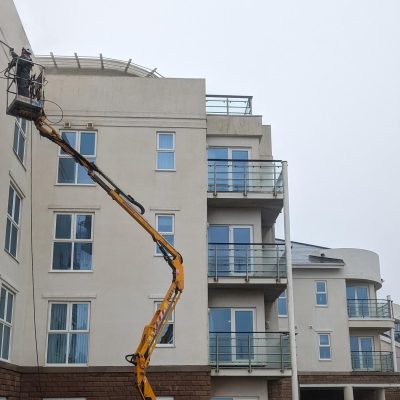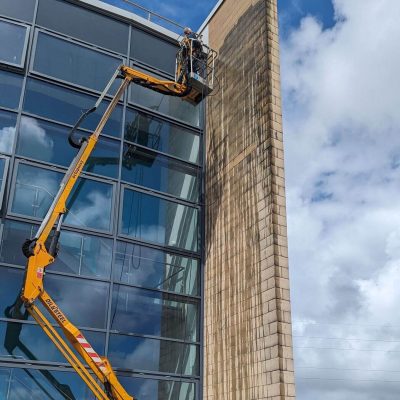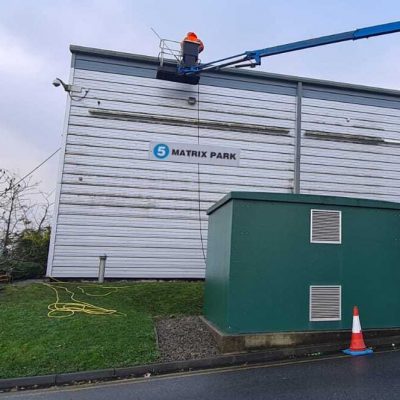Working at height can be dangerous even in ideal conditions. Add wind into the mix, and the risks increase exponentially.
However, many jobs require working at height in less than ideal weather. Construction workers, window cleaners, painters, roofers and others don’t have the luxury of staying safely on the ground on windy days.
While complete avoidance of wind when working at height isn’t possible, proper planning and preparation can help reduce the risks.
There are several dos and don’ts to keep in mind when working at height on windy days. Follow these tips to ensure your safety and that of those working with you.
Assessing the Risks
Do: First and Foremost check the weather forecast before starting work at height. Be aware of predicted wind speeds and gusts in your area. Consider rescheduling work if extreme winds are expected.
Don’t: Attempt to work at height on excessively windy days. As a general rule, refrain from working at height if wind speeds exceed 15 mph. Work should be halted immediately if winds pick up unexpectedly.
Do: Conduct a risk assessment of your specific work site. Consider the height of the structure, proximity to other buildings and terrain that could create tunnelling or gusting winds.
Don’t: Rely on weather reports alone. Local conditions can vary, so assess the actual wind conditions on site before starting work.
Do: Familiarise yourself with the Beaufort Wind Scale. Knowing the effects of different wind forces can help better judge on-site conditions.
Don’t: Underestimate the impact of wind at height. Even moderate breezes can create hazards.
Proper Rigging
Do: Use adequately weighted ballast, sand bags, water barrels or stake anchors to provide stability for ladders, scaffolds, lifts and other equipment.
Don’t: Attempt to operate aerial lifts or cranes in winds exceeding the manufacturer’s recommended limits. Operating in high winds risks loss of control and tip-over.
28mph(12.5 m/s) is maximum wind speed at which Mobile Elevating Work Platforms (MEWPs) are safe to operate.
Do: Rig safety lines and nets on equipment with a high centre of gravity. Nets provide a last line of defence in case of falls.
Don’t: Secure rigging with knots that could loosen and untie from wind vibration. Use secured clip hooks and double wrap rigging to prevent loosening.
Do: Make sure platforms and planks are properly secured. Wind can dislodge improperly installed decking.
Don’t: Use flexible materials like fabric and plastic sheeting that can whip violently in the wind.
Personal Protective Equipment
Do: Wear a safety harness clipped into an anchored fall arrest system. This will stop you if unexpected gusts cause you to lose balance.
Don’t: Wear loose clothing that can billow in the wind and potentially snag on objects. Choose close-fitting apparel secured at wrists and ankles.
Do: Wear a hard hat secured by a chinstrap. Head protection is essential in case of falling debris.
Don’t: Wear a baseball cap or other headwear that can blow off in strong winds.
Do: Wear sturdy work boots with slip-resistant soles for stable footing.
Don’t: Wear shoes with smooth soles that could cause you to slip and slide in gusty conditions.
Safe Work Practices
Do: Keep your centre of gravity low to the surface whenever possible. Crouch or crawl to resist being blown over.
Don’t: Stand fully upright in windy conditions. Remaining low reduces your exposure to strong gusts.
Do: Maintain three points of contact when climbing ladders or scaffolding. This provides stability if wind causes sudden movement.
Don’t: Reach or lean from an elevated position. Stay centred over your footing without overextending.
Do: Work in teams with spotters appropriately positioned. They can warn of impending gusts or debris.
Don’t: Attempt to do the job alone. Having backup is critical when conditions are volatile.
Do: Frequently inspect the work area and equipment for any loose material that could blow away.
Don’t: Leave debris, tools or other items unattended that could be picked up by wind and cause damage or injury.
Handling Unexpected Gusts
Do: Stop working completely when winds exceed safe limits. Seek a sheltered location and wait for conditions to improve.
Don’t: Try to power through in deteriorating weather. Wind forces can rapidly intensify.
Do: Have an emergency action plan for rapid site evacuation and securing of equipment/materials if extreme winds arise.
Don’t: Try to carry on with “business as usual” in exceptionally high or gusty winds. This puts everyone at risk.
Do: Be familiar with any specialty equipment like rope-grabs or retractable lanyards designed to catch you if blown from your footing.
Don’t: Unclip safety lines in an attempt to reach shelter quickly. Remain securely tethered until safely down from height.
Parting Words
Wind can be an unseen yet formidable foe when working at height. But with proper vigilance, planning and training, the hazards of windy conditions can be reduced.
Always keep an eye to the sky and be prepared to halt operations if winds exceed the thresholds of safety. It’s far better to reschedule work than risk life and limb. Your safety is priority number one.



